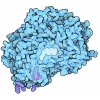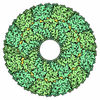[English] 日本語
 Yorodumi
Yorodumi- PDB-7vdv: The overall structure of human chromatin remodeling PBAF-nucleoso... -
+ Open data
Open data
- Basic information
Basic information
| Entry | Database: PDB / ID: 7vdv | ||||||
|---|---|---|---|---|---|---|---|
| Title | The overall structure of human chromatin remodeling PBAF-nucleosome complex | ||||||
 Components Components |
| ||||||
 Keywords Keywords | DNA BINDING PROTEIN / complex | ||||||
| Function / homology |  Function and homology information Function and homology informationsingle stranded viral RNA replication via double stranded DNA intermediate / histone H3K14ac reader activity / positive regulation of glucose mediated signaling pathway / positive regulation of norepinephrine uptake / regulation of DNA strand elongation / positive regulation of telomere maintenance in response to DNA damage / cellular response to cytochalasin B / positive regulation of transcription of nucleolar large rRNA by RNA polymerase I / negative regulation of androgen receptor signaling pathway / bBAF complex ...single stranded viral RNA replication via double stranded DNA intermediate / histone H3K14ac reader activity / positive regulation of glucose mediated signaling pathway / positive regulation of norepinephrine uptake / regulation of DNA strand elongation / positive regulation of telomere maintenance in response to DNA damage / cellular response to cytochalasin B / positive regulation of transcription of nucleolar large rRNA by RNA polymerase I / negative regulation of androgen receptor signaling pathway / bBAF complex / npBAF complex / regulation of transepithelial transport / nBAF complex / brahma complex / morphogenesis of a polarized epithelium / blastocyst hatching / neural retina development / protein localization to adherens junction / postsynaptic actin cytoskeleton / structural constituent of postsynaptic actin cytoskeleton / N-acetyltransferase activity / Formation of the dystrophin-glycoprotein complex (DGC) / GBAF complex / Formation of annular gap junctions / EGR2 and SOX10-mediated initiation of Schwann cell myelination / coronary artery morphogenesis / Tat protein binding / nucleosome array spacer activity / Gap junction degradation / regulation of G0 to G1 transition / Folding of actin by CCT/TriC / Cell-extracellular matrix interactions / dense body / hepatocyte differentiation / XY body / Ino80 complex / regulation of nucleotide-excision repair / Prefoldin mediated transfer of substrate to CCT/TriC / ATP-dependent chromatin remodeler activity / RSC-type complex / apical protein localization / regulation of double-strand break repair / blastocyst formation / RNA polymerase I preinitiation complex assembly / adherens junction assembly / RHOF GTPase cycle / Adherens junctions interactions / positive regulation by host of viral transcription / tight junction / nucleosome disassembly / Sensory processing of sound by outer hair cells of the cochlea / germ cell nucleus / Interaction between L1 and Ankyrins / SWI/SNF complex / regulation of mitotic metaphase/anaphase transition / Sensory processing of sound by inner hair cells of the cochlea / positive regulation of T cell differentiation / cardiac muscle cell proliferation / cellular response to fatty acid / regulation of norepinephrine uptake / transporter regulator activity / apical junction complex / nuclear androgen receptor binding / nitric-oxide synthase binding / positive regulation of double-strand break repair / nuclear chromosome / negative regulation of G1/S transition of mitotic cell cycle / spinal cord development / homeostatic process / maintenance of blood-brain barrier / regulation of chromosome organization / NuA4 histone acetyltransferase complex / establishment or maintenance of cell polarity / cortical cytoskeleton / histone acetyltransferase activity / RUNX1 interacts with co-factors whose precise effect on RUNX1 targets is not known / positive regulation of stem cell population maintenance / Regulation of MITF-M-dependent genes involved in pigmentation / Recycling pathway of L1 / regulation of synaptic vesicle endocytosis / regulation of G1/S transition of mitotic cell cycle / regulation of DNA replication / brush border / regulation of embryonic development / kinesin binding / EPH-ephrin mediated repulsion of cells / negative regulation of cell differentiation / positive regulation of Wnt signaling pathway / ATP-dependent activity, acting on DNA / RHO GTPases Activate WASPs and WAVEs / embryonic organ development / positive regulation of myoblast differentiation / RHO GTPases activate IQGAPs / positive regulation of double-strand break repair via homologous recombination / regulation of DNA repair / regulation of protein localization to plasma membrane / heart morphogenesis / Chromatin modifying enzymes / Regulation of TP53 Activity through Acetylation / DNA polymerase binding Similarity search - Function | ||||||
| Biological species |  Homo sapiens (human) Homo sapiens (human)unidentified (others) synthetic construct (others) | ||||||
| Method | ELECTRON MICROSCOPY / single particle reconstruction / cryo EM / Resolution: 3.4 Å | ||||||
 Authors Authors | Chen, Z.C. / Chen, K.J. / Yuan, J.J. | ||||||
| Funding support |  China, 1items China, 1items
| ||||||
 Citation Citation |  Journal: Nature / Year: 2022 Journal: Nature / Year: 2022Title: Structure of human chromatin-remodelling PBAF complex bound to a nucleosome. Authors: Junjie Yuan / Kangjing Chen / Wenbo Zhang / Zhucheng Chen /  Abstract: DNA wraps around the histone octamer to form nucleosomes, the repeating unit of chromatin, which create barriers for accessing genetic information. Snf2-like chromatin remodellers couple the energy ...DNA wraps around the histone octamer to form nucleosomes, the repeating unit of chromatin, which create barriers for accessing genetic information. Snf2-like chromatin remodellers couple the energy of ATP binding and hydrolysis to reposition and recompose the nucleosome, and have vital roles in various chromatin-based transactions. Here we report the cryo-electron microscopy structure of the 12-subunit human chromatin-remodelling polybromo-associated BRG1-associated factor (PBAF) complex bound to the nucleosome. The motor subunit SMARCA4 engages the nucleosome in the active conformation, which reveals clustering of multiple disease-associated mutations at the interfaces that are essential for chromatin-remodelling activity. SMARCA4 recognizes the H2A-H2B acidic pocket of the nucleosome through three arginine anchors of the Snf2 ATP coupling (SnAc) domain. PBAF shows notable functional modularity, and most of the auxiliary subunits are interwoven into three lobe-like submodules for nucleosome recognition. The PBAF-specific auxiliary subunit ARID2 acts as the structural core for assembly of the DNA-binding lobe, whereas PBRM1, PHF10 and BRD7 are collectively incorporated into the lobe for histone tail binding. Together, our findings provide mechanistic insights into nucleosome recognition by PBAF and a structural basis for understanding SMARCA4-related human diseases. | ||||||
| History |
|
- Structure visualization
Structure visualization
| Structure viewer | Molecule:  Molmil Molmil Jmol/JSmol Jmol/JSmol |
|---|
- Downloads & links
Downloads & links
- Download
Download
| PDBx/mmCIF format |  7vdv.cif.gz 7vdv.cif.gz | 1023.9 KB | Display |  PDBx/mmCIF format PDBx/mmCIF format |
|---|---|---|---|---|
| PDB format |  pdb7vdv.ent.gz pdb7vdv.ent.gz | 767.6 KB | Display |  PDB format PDB format |
| PDBx/mmJSON format |  7vdv.json.gz 7vdv.json.gz | Tree view |  PDBx/mmJSON format PDBx/mmJSON format | |
| Others |  Other downloads Other downloads |
-Validation report
| Arichive directory |  https://data.pdbj.org/pub/pdb/validation_reports/vd/7vdv https://data.pdbj.org/pub/pdb/validation_reports/vd/7vdv ftp://data.pdbj.org/pub/pdb/validation_reports/vd/7vdv ftp://data.pdbj.org/pub/pdb/validation_reports/vd/7vdv | HTTPS FTP |
|---|
-Related structure data
| Related structure data |  31926MC 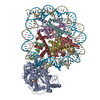 7vdtC M: map data used to model this data C: citing same article ( |
|---|---|
| Similar structure data | Similarity search - Function & homology  F&H Search F&H Search |
- Links
Links
- Assembly
Assembly
| Deposited unit | 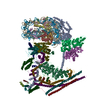
|
|---|---|
| 1 |
|
- Components
Components
-Protein , 10 types, 15 molecules BFCGDHEKNPQRWXa
| #1: Protein | Mass: 11394.426 Da / Num. of mol.: 2 Source method: isolated from a genetically manipulated source Source: (gene. exp.)  #2: Protein | Mass: 14109.436 Da / Num. of mol.: 2 Source method: isolated from a genetically manipulated source Source: (gene. exp.)  #3: Protein | Mass: 13965.265 Da / Num. of mol.: 2 Source method: isolated from a genetically manipulated source Source: (gene. exp.)  #4: Protein | Mass: 15435.126 Da / Num. of mol.: 2 Source method: isolated from a genetically manipulated source Source: (gene. exp.)  #8: Protein | | Mass: 47509.812 Da / Num. of mol.: 1 Source method: isolated from a genetically manipulated source Source: (gene. exp.)  Homo sapiens (human) / Gene: ARP4 / Production host: Homo sapiens (human) / Gene: ARP4 / Production host:  Homo sapiens (human) / References: UniProt: O96019 Homo sapiens (human) / References: UniProt: O96019#9: Protein | | Mass: 41782.660 Da / Num. of mol.: 1 Source method: isolated from a genetically manipulated source Source: (gene. exp.)  Homo sapiens (human) / Gene: ACTB / Production host: Homo sapiens (human) / Gene: ACTB / Production host:  Homo sapiens (human) / References: UniProt: P60709 Homo sapiens (human) / References: UniProt: P60709#10: Protein | | Mass: 97547.102 Da / Num. of mol.: 1 Source method: isolated from a genetically manipulated source Source: (gene. exp.)  Homo sapiens (human) / Gene: ARID2 / Production host: Homo sapiens (human) / Gene: ARID2 / Production host:  Homo sapiens (human) / References: UniProt: Q68CP9 Homo sapiens (human) / References: UniProt: Q68CP9#11: Protein | | Mass: 58254.164 Da / Num. of mol.: 1 Source method: isolated from a genetically manipulated source Source: (gene. exp.)  Homo sapiens (human) / Gene: PHF10 / Production host: Homo sapiens (human) / Gene: PHF10 / Production host:  Homo sapiens (human) / References: UniProt: Q8WUB8 Homo sapiens (human) / References: UniProt: Q8WUB8#15: Protein | Mass: 133048.109 Da / Num. of mol.: 2 Source method: isolated from a genetically manipulated source Source: (gene. exp.)  Homo sapiens (human) / Gene: SMARCC2 / Production host: Homo sapiens (human) / Gene: SMARCC2 / Production host:  Homo sapiens (human) / References: UniProt: Q8TAQ2 Homo sapiens (human) / References: UniProt: Q8TAQ2#18: Protein | | Mass: 116762.430 Da / Num. of mol.: 1 Source method: isolated from a genetically manipulated source Source: (gene. exp.)  Homo sapiens (human) / Gene: PBRM1, BAF180, PB1 / Production host: Homo sapiens (human) / Gene: PBRM1, BAF180, PB1 / Production host:  Homo sapiens (human) / References: UniProt: Q86U86 Homo sapiens (human) / References: UniProt: Q86U86 |
|---|
-DNA chain , 2 types, 2 molecules IJ
| #5: DNA chain | Mass: 63679.574 Da / Num. of mol.: 1 / Source method: obtained synthetically / Source: (synth.) synthetic construct (others) |
|---|---|
| #6: DNA chain | Mass: 64145.816 Da / Num. of mol.: 1 / Source method: obtained synthetically / Source: (synth.) synthetic construct (others) |
-Isoform 2 of ... , 2 types, 2 molecules AT
| #7: Protein | Mass: 169597.938 Da / Num. of mol.: 1 Source method: isolated from a genetically manipulated source Source: (gene. exp.)  Homo sapiens (human) / Gene: SMARCA4 / Production host: Homo sapiens (human) / Gene: SMARCA4 / Production host:  Homo sapiens (human) Homo sapiens (human)References: UniProt: P51532, Hydrolases; Acting on acid anhydrides; Acting on acid anhydrides to facilitate cellular and subcellular movement |
|---|---|
| #12: Protein | Mass: 74385.812 Da / Num. of mol.: 1 Source method: isolated from a genetically manipulated source Source: (gene. exp.)  Homo sapiens (human) / Gene: BRD7 / Production host: Homo sapiens (human) / Gene: BRD7 / Production host:  Homo sapiens (human) / References: UniProt: Q9NPI1 Homo sapiens (human) / References: UniProt: Q9NPI1 |
-Protein/peptide , 2 types, 2 molecules UM
| #13: Protein/peptide | Mass: 613.749 Da / Num. of mol.: 1 Source method: isolated from a genetically manipulated source Source: (gene. exp.) unidentified (others) / Production host:  Homo sapiens (human) Homo sapiens (human) |
|---|---|
| #19: Protein/peptide | Mass: 1379.692 Da / Num. of mol.: 1 Source method: isolated from a genetically manipulated source Source: (gene. exp.) unidentified (others) / Production host:  Homo sapiens (human) Homo sapiens (human) |
-SWI/SNF-related matrix-associated actin-dependent regulator of chromatin subfamily ... , 3 types, 3 molecules VYZ
| #14: Protein | Mass: 44199.188 Da / Num. of mol.: 1 Source method: isolated from a genetically manipulated source Source: (gene. exp.)  Homo sapiens (human) / Gene: SMARCB1 / Production host: Homo sapiens (human) / Gene: SMARCB1 / Production host:  Homo sapiens (human) / References: UniProt: Q12824 Homo sapiens (human) / References: UniProt: Q12824 |
|---|---|
| #16: Protein | Mass: 60127.332 Da / Num. of mol.: 1 Source method: isolated from a genetically manipulated source Source: (gene. exp.)  Homo sapiens (human) / Gene: SMARCD1 / Production host: Homo sapiens (human) / Gene: SMARCD1 / Production host:  Homo sapiens (human) / References: UniProt: Q96GM5 Homo sapiens (human) / References: UniProt: Q96GM5 |
| #17: Protein | Mass: 46710.371 Da / Num. of mol.: 1 Source method: isolated from a genetically manipulated source Source: (gene. exp.)  Homo sapiens (human) / Gene: SMARCE1 / Production host: Homo sapiens (human) / Gene: SMARCE1 / Production host:  Homo sapiens (human) / References: UniProt: Q969G3 Homo sapiens (human) / References: UniProt: Q969G3 |
-Non-polymers , 3 types, 3 molecules 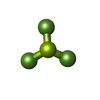




| #20: Chemical | ChemComp-BEF / |
|---|---|
| #21: Chemical | ChemComp-MG / |
| #22: Chemical | ChemComp-ADP / |
-Details
| Has ligand of interest | Y |
|---|
-Experimental details
-Experiment
| Experiment | Method: ELECTRON MICROSCOPY |
|---|---|
| EM experiment | Aggregation state: PARTICLE / 3D reconstruction method: single particle reconstruction |
- Sample preparation
Sample preparation
| Component | Name: The motor-nucleosome module of human chromatin remodeling PBAF-nucleosome complex Type: COMPLEX / Entity ID: #1-#19 / Source: MULTIPLE SOURCES |
|---|---|
| Source (natural) | Organism:  Homo sapiens (human) Homo sapiens (human) |
| Source (recombinant) | Organism:  Homo sapiens (human) Homo sapiens (human) |
| Buffer solution | pH: 7.5 |
| Specimen | Embedding applied: NO / Shadowing applied: NO / Staining applied: NO / Vitrification applied: YES |
| Vitrification | Cryogen name: ETHANE |
- Electron microscopy imaging
Electron microscopy imaging
| Experimental equipment |  Model: Titan Krios / Image courtesy: FEI Company |
|---|---|
| Microscopy | Model: FEI TITAN KRIOS |
| Electron gun | Electron source:  FIELD EMISSION GUN / Accelerating voltage: 300 kV / Illumination mode: OTHER FIELD EMISSION GUN / Accelerating voltage: 300 kV / Illumination mode: OTHER |
| Electron lens | Mode: BRIGHT FIELD |
| Image recording | Electron dose: 50 e/Å2 / Film or detector model: GATAN K3 (6k x 4k) |
- Processing
Processing
| CTF correction | Type: NONE |
|---|---|
| 3D reconstruction | Resolution: 3.4 Å / Resolution method: FSC 0.143 CUT-OFF / Num. of particles: 137659 / Symmetry type: POINT |
 Movie
Movie Controller
Controller





 PDBj
PDBj












































